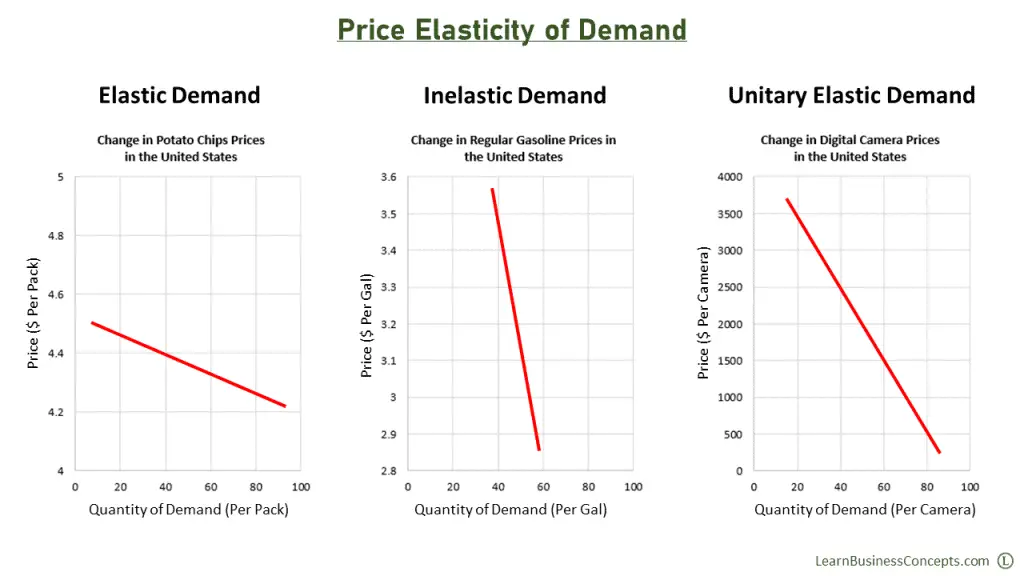Price Elasticity of Demand Explanation
What is Price Elasticity of Demand
Price elasticity of demand is the measure of the sensitivity to a change in consumption of a product with a change in the price. Price elasticity is used to understand how will the consumption of a product differs when the price varies.
In the technical terms of economics, price elasticity is known as the extent to which the demand and supply of a commodity is change in response to a change in the price.
Following is the formula of the price elasticity of demand,
Price Elasticity of Demand = Percentage of the Change of Commodity’s Quantity Demand / Percentage of the Change of Commodity’s Price
Almost for every product, when the price rises the quantity demanded falls. But the quantity demand of some products falls more than the others. This is the concept behind the price elasticity of demand.
There are three types of price elasticity of demand.
Types of Price Elasticity of Demand
Elastic Demand
Demand for a product is elastic when a price change has a relatively large effect on the quantity of the product demand. This is where a reduction in price does raise demand much, and an increase in price does fall demand much.
Products that have elastic demand show a larger variation in the demanded in response to even a minor change in price. This means a one percent price rise leads to a ten percent decline in quantity demanded.
Inelastic Demand
Demand for a good is inelastic when a price change has a relatively small effect on the quantity of the good demand. This is where a reduction in price does not raise demand much, and an increase in price does not fall demand much.
Products that have inelastic demand show only a minor variation in the demand, in response to a change in price. This means a ten percent price rise leads to a one percent decline in quantity demanded.
Unitary Elastic Demand
Demand for a good is unitary elastic when the percentage change in quantity demanded is equal to the percentage change in price. This is where a reduction in price equally raises the demand, and an increase in price equally falls demand.
Products that have unitary elastic demand show an equal variation in the demand, in response to the change in price. This means a one percent price rise leads to a one percent decline in quantity demanded.
Please refer to the below Article for other additional two types of Elasticity of Demand,
Examples of Price Elasticity of Demand

1) Examples of Elastic Demand
Products that have elastic demand show a larger variation in the demanded in response to even a minor change in price.
If the price of a pack of potato chips that you purchased every day raises $0.50, how it will affect your purchase? You probably would move to another snack as long as you are not super attached to potato chips.
In general, food items, luxury items, and fast-moving goods are elastic since these products are replaceable on another product.
2) Examples of Inelastic Demand
Products that have inelastic demand show a small variation in the demand, in response to a change in price.
If the price of a Regular Gasoline increased by $0.50, how it will affect your gas purchase? There will be only a minor variation. Gasoline is an essential item for us to meet our transportation needs. This product is not easily replaceable as well (even electric vehicles are there).
In general, gasoline, utilities, tobacco products, medical treatments, and prescription drugs are inelastic since these products are not easily replaceable with other products.
3) Examples of Unitary Elastic Demand
Products that have unitary elastic demand show an equal variation in the demand, in response to the change in price.
If the price of a digital camera increased by $500, how it will affect your purchase? There would be an equal level of demand decrease for this.
Products like mobile phones, home appliances, essential electronic products are considered unitary elastic.
Recommended Articles:
- Types of Price Elasticity of Demand – Full Explanation
- Unitary Elastic Demand: Definition, Examples, Curve
- Inelastic Demand: Definition, Examples, Diagram
- Perfectly Elastic Demand: Explanation with Examples
- Difference Between Elastic Demand and Inelastic Demand
- Difference Between Unitary Elastic and Inelastic Demand
- Explanation and Calculation of Elasticity Coefficient


